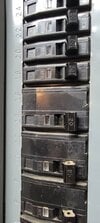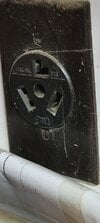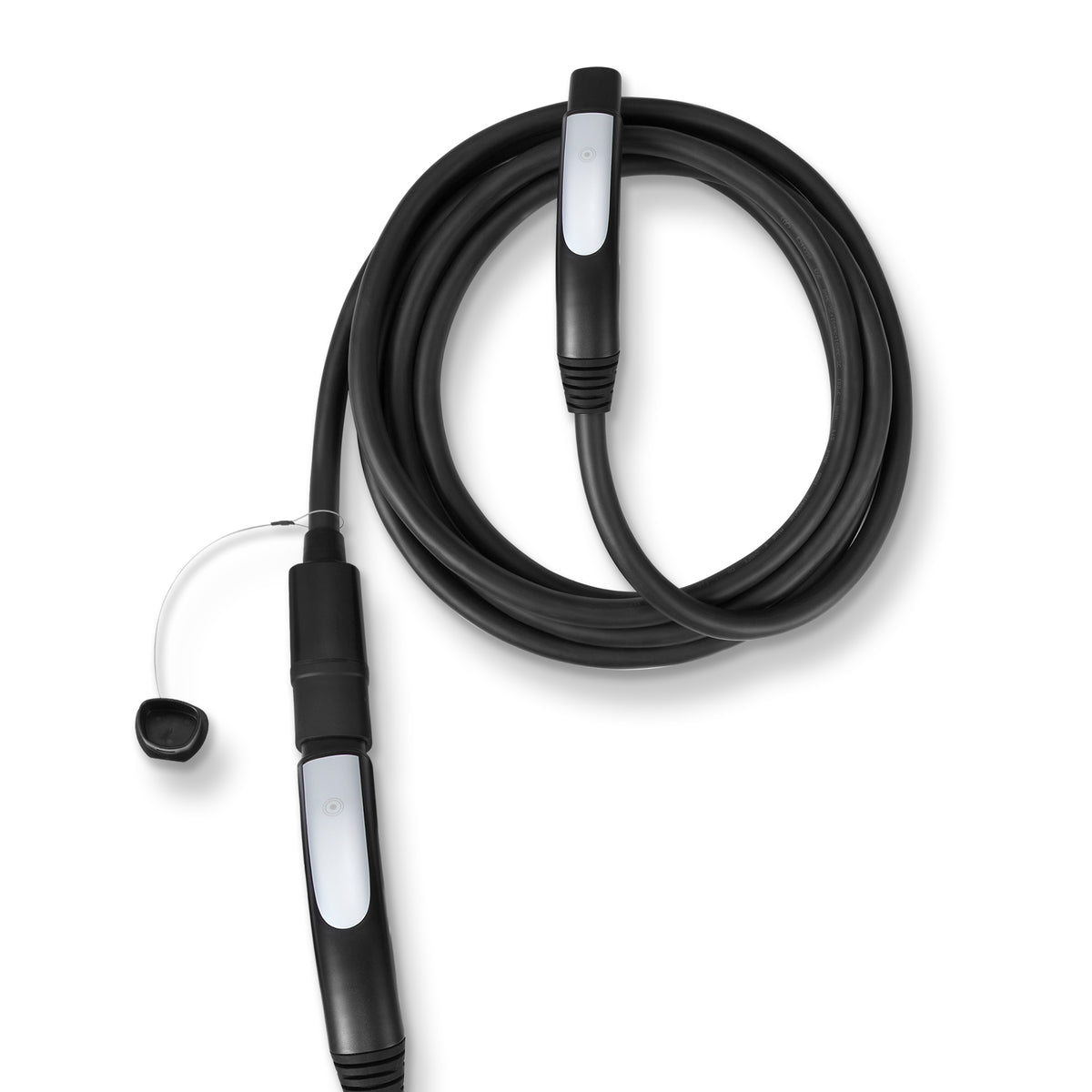All right. There's something seriously weird going on here. @FlynHokia, it's like this.
First, for you continuing edification, here's the cheat sheet, straight from Wikipedia:
So, what you've got there is a NEMA10-30. That's a Type 10, 30 Ampere connector, fourth row down from the top, third from the left.
Next: As you're probably painfully aware, most houses in North America get split phase. That is, coming down from the power pole, a Neutral, then a Hot that we'll call Hot #1, and another Hot, that we'll call Hot #2.
If one gets out an AC voltmeter, the voltage between Hot #1 and Neutral is 120 VAC. The voltage between Hot #2 and Neutral is
also 120 VAC. There's a sine wave of voltage on Hots #1 and #2; but the sines are
inverted with respect to each other. So, when Hot #1 is going up in voltage, Hot #2 is going down.
If one puts an AC voltmeter between Hot #1 and Hot #2, you get 240 VAC.
Inside the breaker box, it's arranged so that the first slot is on one Hot bus bar, the next slot is on the next Hot bus bar, then back to the first, and so on. So, a double-wide breaker hits both bus bars, and that's how one gets a 240 VAC circuit.
Now, there's a problem with your setup. And it has to do with amperage. The National Electric Code says that a breaker, the socket to which the breaker is connected, and the wire
all has to be able to carry the same rated current. That "-30" means that that's a 30A socket. If someone has a welder or something that says, "24A" or whatever, and it comes with a NEMA10-30 plug on the end of its cable, then it's going to draw 24A at times, at least as a transient.
The blinking breaker has to match. That's
always been code. I absolutely, positively, guaranteededly state to you that that installation has
never seen an electrical inspector. And if it had, they had to bury the body, because the electrical inspector would have fainted dead away had he/she seen that.
There's a very solid reason for this: It's all about the heat. Power dissipated in a conductor, either a wire or the blinking contacts inside that socket, goes as current*current*resistance, where the resistance is the resistance of the metals in there. Further, when power gets dissipated in a metal, the metal gets hot. A NEMA10-30 is
designed to provide a path for that heat energy to leave the socket and Go Somewhere Else, like the ambient environment. If it doesn't (say, one puts the connector in a thermally insulated box or something) it'll just keep on getting hotter until it either burns the insulation or melts.
OK: So, you've got a 20A breaker on a 30A socket. What's the problem with that? Won't the breaker just pop if one tries for the rated current?
This is called, "You Bet Your Life." A breaker is a save-the-day object. It's
not supposed to operate unless it's saving the day. People who go for what are laughingly called Nuisance Trips are playing with, literally, fire here: Breakers are thermal mechanical devices that
can wear out. If one wears out and it gets stuck open, then, in a way, that's not so bad. No current flows. But if it fails stuck closed, then you no longer have a safety device. Then, if a short occurs, it's house burning down time.
NEC rules say that, with a continuous heavy load (hello, Tesla!) the maximum amount of current on a circuit is 80% of the rated current. That's because when a circuit is running continuously, it's not like there's a sudden slug of, say, 35A when a motor starts up, and 15A thereafter; with a 30A circuit, one should have, when charging a Tesla, 24A (80% of 30A). Running more than that risks heating wires and connectors and such warmly enough that
the insulation is degraded.
Now, you're saying you've got some 10 Ga wire in there. I don't know what kind of insulation said wire is running. (And, yeah, that matters, because the insulation is a
heat conductor and various different insulations have different resistance to degradation with temperature.) But, a quick look gets you
this link.
It says that 10Ga wire should suffice for 30A service. But, like I said, you don't have a 30A breaker in there.
So, this is why you bring an electrician in. Here's the deal: If you have, I dunno, 100A service to your house, there should be the Main Breaker at the top of your breaker panel, and it'll be labeled "100A".
Now, if you get out a pencil and add up the numbers of all the
other breakers in that panel, you'll discover that all of the other breakers add up to more than 100A. So, what gives?
Answer: Nobody turns everything on at the same time with the max current on each circuit. There's a procedure for sizing a breaker panel, and it's called Load Analysis, it's NEC mandated, and electricians do this all the time. Your house and breaker panel may have Zero problems replacing that 20A duplex breaker you have in there with a 30A breaker, and the electrician will tell you that. If things are overloaded and you need a Bigger Panel, they'll tell you that, too.
You can get a NEMA10-30 adapter from Tesla, plug that into a Mobile Connector, and put that into the socket. The TMC is pre-programmed so if it sees a NEMA10-30 adapter, it'll tell the car to go ahead and draw 24A. Which You Do Not Want To Do until that breaker gets swapped out for the right sized one.
Finally: There's decent reasons that you might want to quit futzing around with this NEMA10-30 and go for a hard-wired connection, either with a Tesla Wall Connector (TWC) or similar from some other company:
- If one follows modern code (which.. you might be grandfathered into..) one is supposed to have a GFCI circuit for something going into the garage. On that 240 VAC circuit. Such a beast is $150-$200. This could be a sticking point if you ever sell the house and some home inspector spots the problem.
- A TMC costs around $220 or so. Tesla stopped shipping them with their new cars because, well, nobody was using them. So, you'd have to buy one of those things.
- People have discovered, to their sorrow, that plugging in/unplugging NEMA14-50 and the like results in wear-out and melted connectors. Industrial grade sockets last longer but cost, like, $120 or so.
- So: Total cost of an in-code car charging station is around $500 or so, just for the hardware.
- My understanding is that a TWC is around $350 these days, has a GFCI built in, and it takes a really long time to wear one out. If you got another couple hundred to run a 60A circuit out to the garage, assuming the load analysis supports it, then it might be $600 or so for the whole business, giving you 48A charging of the car. Or any future BEVs you might end up with.
FWIW, at my place, the breaker box just so happened to be
in the garage, there was a spot between the two garage doors for a TWC, so I paid the grand or so to put in the hardware. Back in 2018. Still working just fine.






